|
Monday, May 24, 2010
Progress Notes
This week I am going to review some of the history of the John N. Brockman family of Tuscumbia.
Last year I wrote an article about the Brockman family describing some historical artifacts which were given to the museum by Jay Brockman (photo 01), grandson of John N. Brockman and former resident of Tuscumbia.
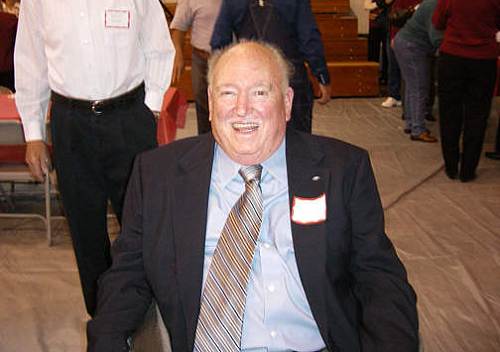
01 Jay Brockman In the article I also wrote about the Brockman Hotel which had been owned by Jay’s grandfather, John N. Brockman. The hotel had a rich and long history in Tuscumbia before being razed in 1968 (photos 02, 03 and 04).
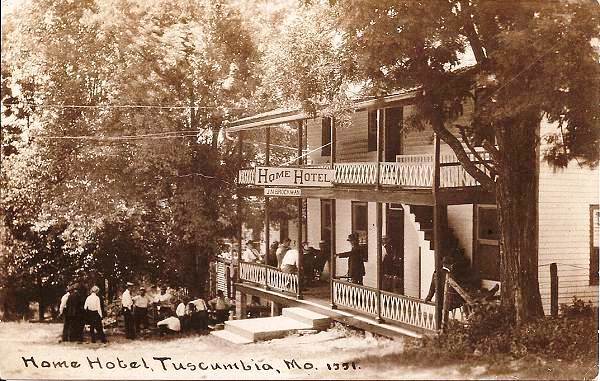
02 Brockman Home Hotel
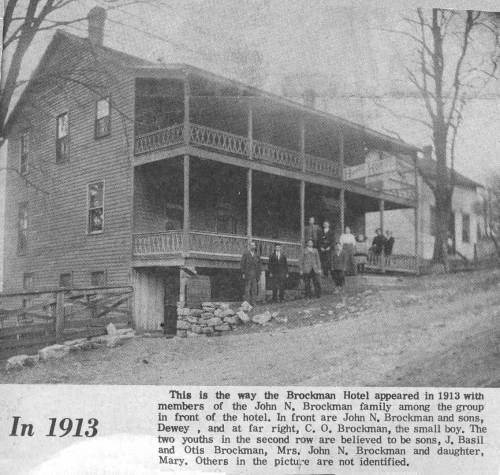
03 Brockman Home Hotel - 1913
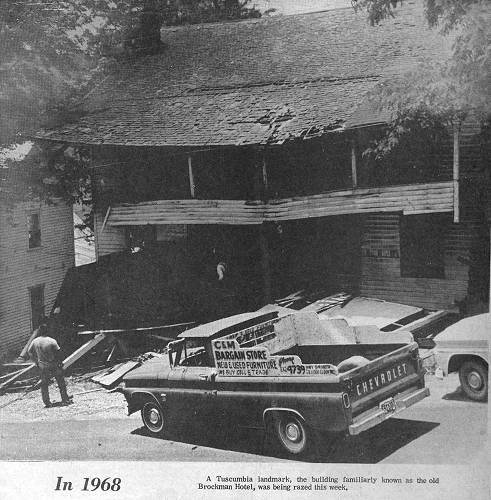
04 Razing of Brockman Home Hotel - 1968 The article contained much information about the Brockmans’ especially regarding the Brockman Hotel so for completeness you really should read it. However, because it is long I won’t repeat it here but you can access it at this previous Progress Notes.
Three different families with the Brockman surname settled in Miller County according to genealogist DeVere Whitaker. Jay Brockman’s family arrived in Miller County in the 1820’s eventually settling along the Osage River at a river crossing which in later years and even today bears the name “Brockman Ford.” Clyde Lee Jenkins in his History of Miller County records this interesting story about the first Brockman to settle on the Osage River, John M. Brockman, who was the great great grandfather of Jay Brockman:
Judge Jenkins’ History of Miller County p. 20
Hearing of very fertile land along the Osage River, in the late 1820’s, John M. Brockman settled six miles above latter day Tuscumbia, by a big spring. He moved there with a yoke of oxen, an ox cart, a gun, a double bit axe, and a few hand tools from in the vicinity of a very small settlement called Pleasant Mount on the prairie. He cleared with great toil an area out of the wilderness near the big spring. In a short time he was joined by a stranger from the other side of the river. The stranger carried information that if logs were to be raised for a cabin, Mr. Brockman could find a pattern already cut on the other side of the Osage. He had the logs for a cabin ready to be raised, but there were too many Indians. They had not molested him in any way, but friendly or not their standing and sitting around watching while he worked made him nervous. He was returning to civilization and giving his tenancy book to the Indians. He was returning to the vicinity of Pleasant Mount on the prairie.
John M. Brockman crossed the river and found the pattern. In a few days the logs were raised and the cabin completed. The Indians remained in the vicinity several weeks. Later, the land was patented by Mr. Brockman during the administration of President Andrew Jackson. This farm remained in the Brockman family until 1948, more than 120 years. The Brockman farm, the Brockman Ford across the Osage River, the Brockman Ferry, the Brockman steamboat landing, and the Big Spring, were early landmarks in Miller County.
Here is a plat map which shows the Brockman farm in section 10 (photo 05):
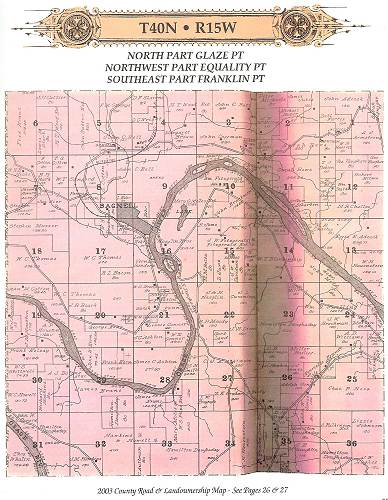
05 Plat Map T40N R15W - Section 10
Click image for larger viewThe original farm eventually passed down to Jay’s grandfather, John N. Brockman (photo 06).
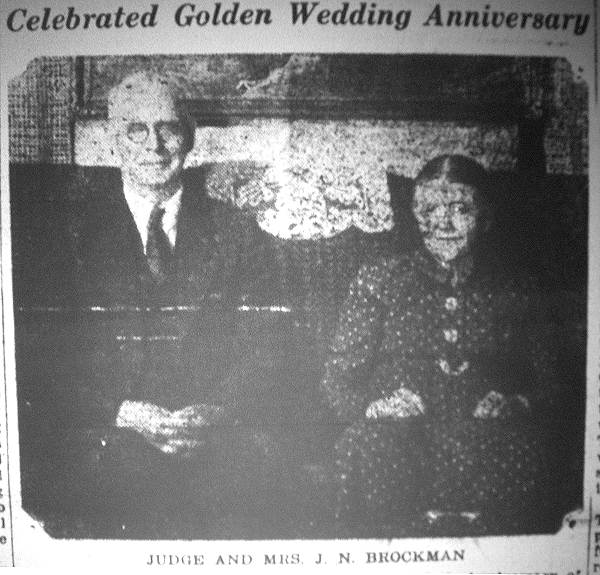
06 Judge and Mrs. John N. Brockman I asked Jay to write a summary of his memories of his grandfather John and his father Oliver Brockman when he was a young boy. Here is the letter he wrote me:
Hi Joe,
So good to hear from you again.
The John Brockman who owned and operated The Home Hotel in Tuscumbia, The Tuscumbia Telephone Company, The Brockman Ford Farm, the Bagnell Ferry at various times, and who was elected as Miller County Judge of one of the districts, and Presiding Judge of Miller County was my grandfather.
He was the father of Roy Brockman, Otis Brockman, Basil Brockman, Dewey Brockman, C. Oliver Brockman, and Mary (Brockman) Starling. He baby sat me every Saturday night back when my Mother and Father went out dancing and partying on Saturday nights. (Grandad and I listened on the radio to The Louisiana Hayride, The National Barn Dance out of Cincinnati, The Grand Ole Opry on WSM clear channel out of Nashville, Tennessee, the Ernest Tubb Record Shop, and into the early morning hours each Sunday to various radio shows of country music out of Del Rio Texas. Thus my INTENSE love of the old time country music and my love of tap and jig dancing to whole sets of square dancing.
When I got a little older and Basil's family lived on and farmed the Brockman Ford farm, I'd go up and stay with them for several weeks at a time and we'd roll back the rugs in the main living areas of the house. All the neighbors brought in their musical instruments and we'd have a dance right there in the Brockman Ford farmhouse. Basil's wife Anna (Hinds) and children were extremely talented in music. Out of that group of neighbors to the Brockman Ford farm Gloria (Brockman) Bradley taught piano on her three Grands to Mizzou students in Columbia, MO and Melvin Bradley (one farm up stream on the Osage) became a nationally renowned stock judge and published at least three books on the Missouri Mule. I have autographed copies in our library.
Note: Melvin Bradley was born and raised in the Horseshoe Bend area of the Lake (photo 06a).
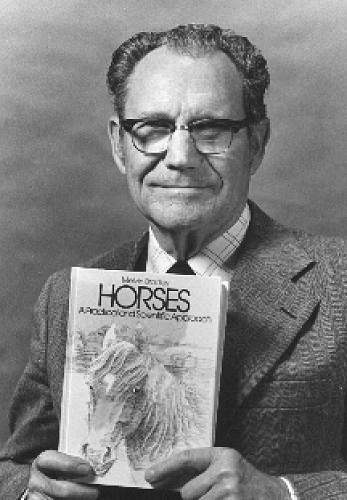
06a Melvin Bradley The time frame in which Jay was writing about above was probably in the mid 1930’s. At that time the Bradleys’ owned a farm next to the Brockmans’. Melvin Bradley was quite an important figure being accredited as being the leading expert on Missouri Mules, as Jay mentioned above. He passed away in 2003. If you would like to know more about this famous central Missouri citizen refer to this website.
The “N” in granddad’s name stood for Northrip. There has been some dispute about the spelling of his middle name but I have researched it many times and always arrived at the conclusion that it is correctly spelled as Northrip.
One of John Northrip and Eliza (Wilcox) Brockman's sons, Roy, was named Roy Ambrose after John N.'s father.
As to why I was born in Oklahoma, my mother (Ila Calkin) was a teacher in Bagnell and had relinquished her position in order to marry my father just as The Great Depression was nearing its crest. Dad (Oliver) was a switchman on the Frisco Line in Tulsa until he relinquished his job (photo 07).
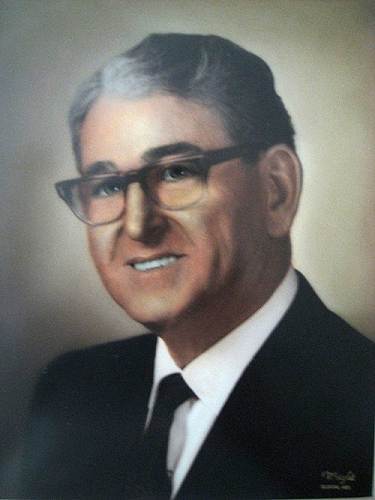
07 Oliver Brockman After trying for what must have seemed like an eternity to get his job back, Dad came back to Miller County, reworked three rooms of the Home Hotel (the name before grandfather owned it) to a combination telephone switchboard, living room, bedroom, and a kitchen. Mom played up to the owner of the Tuscumbia Telephone Company and got a job as switchboard operator and Dad got a job on a rock pile for $1.50 per day and had to bring his own tools. Earlier in life Dad had been Superintendent of the Bagnell schools. When word got around that he was back and jobless, he soon got a job teaching at Walnut Grove School. Wiener roasts at the end of the school year then were like a filet today.
There were four of us grandkids (from different sons of John N.) who were born in Oklahoma and stayed varying amounts of time there. I grew up getting to go back and visit once in while thinking that anything connected with Oklahoma was the very best.
The Judge as many called my grandfather John spent a world of time with me and we were extremely close. We were much closer than my father and I. I used to go with him and cut weeds on his parent’s graves. After the funerals of his mother and father the caskets were transported from the Brockman Ford farm to the cemetery over next to the Glenn Warren farm by Jon boats. Would you like me to show you those graves and the tomb stones? You may have already seen them, I don't know.
I learned to drive his 1931 Chevy with a stick shift with a hand emergency brake.
On the night of my grandfather's funeral the whole family was sitting around telling things they remembered hearing from my grandfather and all of John N.'s boys verified that when the Brockmans settled on the Brockman Ford Farm, Indians were camped on the other side of the river.
|
Thanks Jay.
Nancy Thompson, genealogist and museum director, researched the family tree of Jay’s Brockman family which contains several interesting historical side notes she discovered and added to the genealogy. You can read it here (photo 08):
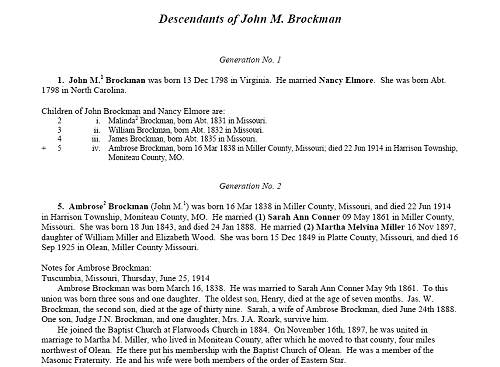
08 Decendents of John M. Brockman
Click image to view complete document in PDF formatAnother interesting summary of the life of John N. Brockman was published in the Miller County Autogram in 1952:
Miller Count Autogram
1952
A family history dating from the pre organization days of Miller County was related this week by Judge J.N. Brockman of Tuscumbia. The Brockman family, one of the oldest in the county, has been closely connected with the growth of this central Missouri region for more than a century and a quarter.
The Brockman family first settled in the area later organized as Miller County in 1820 when John M. Brockman, grandfather of Judge Brockman, entered and received a patent on a farm located about 5 miles up the river from Tuscumbia near a well known landmark called Brockman Ford. He and his wife, Nancy Elmore Brockman, were the parents of 10 children: Susan, Anna, Henry, Sally, John E., Malinda J., William T., James M., Lucinda Ann and Ambrose.
Mr. Brockman, who was one of the pioneering Miller Countians, helped organize the Osage Valley Baptist Association (which was later changed to the Miller County Baptist Association) and served as moderator for several years. He was probably the first ordained Baptist minister in the county, being ordained in 1842.
He received his license to preach on the first Saturday in April, 1839. Judge Brockman still has the document. The Reverend Mr. Brockman’s first pastorate was the Gilgal Church, located about one mile from Bagnell.
His son, Ambrose, owned the farm all of his life, and, but for a short time, lived on it until his death. His wife was Sally Ann Conner Brockman and they were the parents of James W., John N., and Mary Jane. The children were all born and reared on the Brockman Ford farm which remained in the family until 1945 when it was sold by Judge Brockman to Wilford Robinson.
Judge Brockman was born in 1865. His early school days were spent in the Lawson and Buck Knob rural schools. He attended the Spring Garden Institute after finishing grade school. He taught for about 7 years in rural schools…Lawson, Buck Knob, Elm Springs, Post Oak, and Barnett, located near Bagnell.
Later he moved to Bagnell where he operated the ferry for about 9 years (photo 09).
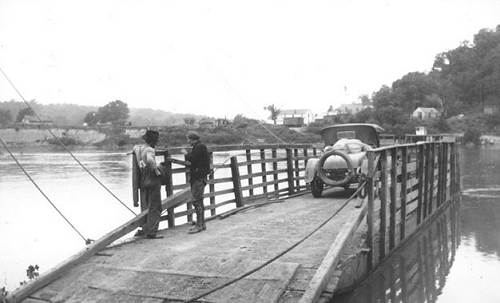
09 Bagnell Ferry An amusing incident, he recalls in his ferry boating days, was the time when he tried to take a pig across on the ferry. The man the pig belonged to had taken his horse and buggy across empty and had attempted to make the pig stand on the ferry, but it was a bit stubborn. Rather than ride the ferry, it jumped into the river and would have drowned, but Mr. Brockman caught its ears and dragged it across the river, holding its nose above water. Fare for the man was 3c, but Brockman thought that fare for the pig ought to be 25c.
Another time he saved a man from drowning when he fell through the ice while walking across the river in winter. The man was Jack Mace, rural mail carrier from Ulman to Bagnell. Mr. Brockman extended a pole with a hook on it and caught Mr. Mace by the coat sleeve and with some help dragged him from the water and onto the boat. Mr. Mace was the grandfather of Lucian Mace, a local resident.
Note: you can read the story of Lucian Mace at this previous Progress Notes.
In 1886, Mr. Brockman was married to Eliza C. Wilcox, daughter of P.M. and Minerva Duncan Wilcox, who was born at Wilcox Bend, near Bagnell. To this union eight children were born, two dying in infancy.
One son, Roy A. died in 1920. He was married to the former Ethel Bealer and they had one child, Mrs. Bruce (Lucille) Lambert. Mrs. Lambert and her husband are both attorneys of law. She is, at present, assistant attorney of Arlington County, Va., the first woman in the state of Virginia to hold that title. The position is similar to prosecuting attorney in Missouri.
James Basil Brockman was married to Anna Hinds, granddaughter of Pinckney Miller, said to be the first white child born in Miller County. They are the parents of three children, Earl, Gloria (Mrs. Melvin Bradley) and John B. They now reside in Huntington Park, California.
John Otis married Bernice Daley of San Francisco, California and they are the parents of two children, Mildred (Mrs. Arnes Kemper) and John Otis Jr. (Jack). They reside in Burlingame California.
Dewey P. who lives in Kansas City, married Mae Davenport. They are the parents of three children: Mrs. Lois Snodgrass, Doris, and John T., who was killed while on duty with the U.S. Navy in Japan.
Clinton Oliver and Ila Calkin Brockman have one son, Jay C. who is stationed with the U.S. Navy in Germany.
One daughter, Mrs. Mary Starling (late husband, Roy) has a daughter, Betty Nell.
Judge Brockman also has several great grandchildren. They are Ames, Jr. and Bruce, sons of Mr. and Mrs. Ames Kemper. Glenna Lou, daughter of Mrs. Lois Snodgrass; Judy and Janis Brockman, daughters of John H. and Faye Brockman, and David Allen Bradley, son of Mr. and Mrs. Melvin Bradley.
In 1895, Judge Brockman united with the Flatwoods Baptist church, located near the Glen Warren farm, later moving his membership to Tuscumbia where it still is.
In 1904, Mr. Brockman was elected as district judge on the Democrat ticket in a county that is staunchly Republican. He served two consecutive terms before being elected presiding judge in 1926. In 1930, he was again elected district judge, and served for three consecutive terms. It is no wonder that he is better known as “Judge Brockman.”
He recalls the first winter that he was judge. He was then living at Bagnell and came by boat to Tuscumbia to attend court. But, as the river was frozen, the boats could not travel, so he skated to court down the river on the ice.
Before moving to Tuscumbia, he held the position of postmaster at Tuscumbia for several years, a position his son, Oliver, now holds.
After moving to Tuscumbia, he operated a general merchandise store with Fred Short and with Zed Livingston. Other businesses in Tuscumbia at that time were a drugstore operated by Dr. Kouns and Dr. Dixon, who also had a general medical practice; a blacksmith shop owned by Ed Kallenbach; a restaurant operated by Burl Burris; a general merchandise store operated by George Hauenstein, a hardware store operated by George Swanson; Johnson’s Café; the Anchor Milling Company; the Bacon House Hotel; and a livery stable operated by Billy Burris.
In 1913, Mr. Brockman purchased the hotel building where he now lives.
He recalls the time that he and three other men hired Mr. Burris, who operated the livery stable to take them to Eldon in his surrey. On the way they got stuck in the thick mud and had to walk part of the way until the horses could pull the surrey out. This is an example of how our roads have improved since that time.
Judge and Mrs. Brockman celebrated their golden wedding anniversary in 1936. All of their children were present at the festive occasion held in the park pavilion. Before Mrs. Brockman passed away last year, they had celebrated their 65th anniversary.
Among the judge’s many treasures is an encyclopedia his grandfather bought which is estimated at more than 100 years old, and a family Bible purchased in 1903. However, this is not the original family bible. It burned with the farm home in 1902. He also has a portrait of his wife and each child. He has a group picture of four generations taken in 1913 of himself, his father, his son, Basil, and Basil’s son, Earl. He has a picture of himself and his brother and sister that was taken long before that. He also treasures a friendship quilt that was pieced by Mrs. Brockman about 65 years ago.
The wedding anniversary to which the article above referred also was recorded in the Miller County Autogram which I copy here:
Miller County Autogram
November 19, 1936
Judge and Mrs. J.N. Brockman Honored on Wedding Anniversary
One of the very pleasant events of the week was enjoyed last Saturday, November 14, when relatives and friends were joined in an informal dinner in the Dining Pavilion of Tuscumbia’s Riverside Park in Honor of the fiftieth wedding anniversary of Judge and Mrs. J.N. Brockman of Tuscumbia.
The dinner was an open affair to relatives of either the bride or groom and guests of the wedding fifty years ago, also to a few elderly friends in Tuscumbia, and to the Honorable Congressman William L. Nelson and son William L. Jr. of Columbia, Missouri, who have been close friends of the family for a number of years.
The pavilion was beautifully decorated with silver and gold emanating from the centerpiece, supporting a large three tier cake, upon which stood a miniature bride and groom surrounded by white daisies, symbolic of the daisy head wreath the bride wore at the wedding, above which swayed in the breeze a twenty two inch silver bell bearing the golden “Fifty.” The tables were incorporated with the centerpiece by silver and gold streamers from each table to the centerpiece. Plates were set for sixty two guests around the horseshoe table. At the noon hour a picture of the setting was made by H.S. Kilgore, photographer of Eldon.
Following the serving of a turkey dinner, the bride cut the mammoth three tier cake which carried the silver and gold color scheme throughout, baked by Mrs. Robert Howser of Eldon, a niece of Mrs. Brockman, after which short talks of guests present were given of reminiscences of the wedding. It developed that the Brockman family homesteaded at what is known as Brockman’s ford on the Osage River about five miles west of Tuscumbia in 1820, and that the family of the bride settled on a farm about three miles west of the ford in a bend that takes its name from that family….Wilcox. The Wilcox family remained owner of that tract until near the twentieth century and the farm at Brockman ford is now owned by the groom, having been in the family name since it was entered in 1820.
After marriage the couple lived on the farm for a few years before going into business at Bagnell. Mr. Brockman was owner of the ferry boat across the Osage at that point and for a number of years was in the mercantile business and postmaster there. About 1906 he was elected Associate Judge of the County Court, First District, and moved his family to Tuscumbia where he entered the mercantile business. Following four years on the farm again he went into business at Etterville and Eugene where he owned and operated hotels and two livery barns. In 1913 he returned to Tuscumbia and entered the mercantile business until he was appointed postmaster here, serving until 1921. In 1926 he was elected Presiding Judge of the County Court; in 1928, he was elected again to Judge of the First District and having been reelected 1930, 1932, and 1934 still holds that position.
Following the reminiscences of the wedding telegrams and messages of congratulation were read and were followed by a very appropriate eulogizing talk by Congressman Nelson, in which he paid tribute to the accomplishments of the couple in achievements for the community in which they lived, for the family which they had reared, and for the noble Christian lives they had lived in the more than three score and ten years in this county.
During the time they were located in town, Mrs. Brockman operated hotels in Bagnell, Etterville and Tuscumbia from 1915 until ill health forced her retirement last year. She is the mother of five living children and eleven grandchildren. All the children were present for the occasion, which happened to be the first time they have all been together in twenty one years. Mr. and Mrs. J.B. Brockman and sons Earl and J. B. and daughter Gloria Ann, of Tulsa, Oklahoma; J. O. Brockman and wife of San Francisco, California; Dewey P. Brockman and wife and daughters Lois, Dorris and son John B. of Kansas City Missouri; Mr. and Mrs. C.O. Brockman and son J.C. of Tuscumbia; and Mr. and Mrs. Roy Starling and daughter Betty Nelle of Eldon, Missouri; also Mrs. James Tracy…formerly Mrs. Roy Brockman…and daughter, Mrs. Jack Gamble of Eldon, Missouri, composed the family group. Others present were, besides those already mentioned: Mr. and Mrs. Marshall, who celebrated their fifty fourth anniversary last year; Dr. and Mrs. D.H. Kouns and son C.F., who will celebrate their golden anniversary next year; Mrs. Belle Fendorf, Mrs. Lena Blackburn, Miss Viola Scrimager, and J.E. Kallenbach, all of Tuscumbia; Elmer Evana of Ulman…one of the wedding guests; Mr. and Mrs. Robert Howser of Eldon, Mr. and Mrs. William Robbin of Kansas City; Mrs. Janie Roark and sons Julius and Willard, Mrs. Vernie Wyrick, Mr. and Mrs. Tennyson Howser and E.P. Clark, all of Eldon; Mr. and Mrs. P.T. Thornsberry and daughter Elaine of Strafford, Missouri, and Miss Boeger, also of Strafford; Mr. and Mrs. O. J. Gray of Eugene, Mrs. Hattie Slote, Lee Thomson and James E. Shelton.
Following the dinner program the guests all joined in singing “God Be With You Till We Meet Again.”
About eight thirty in the evening a group of town friends gathered at the home of the couple and gave a serenade of songs, including: “When You and I Were Young Magie,” “Old Grey Bonnett,” etc. after which they were invited in the home and treated to apples, old fashioned stick candy and cigars. After visiting for awhile and wishing the couple many pleasant returns of their anniversary the guests departed. Those composing the group were Mr. and Mrs. T. C. Wright, Judge W.S. Stillwell and daughter Mildred, Mr. and Mrs. C.E. Fendorf, Mr. and Mrs. E.A. Condra, Garrett A. Berry and son Conley, Mrs. D.E. Kallenbach, Mrs. B.B. Grey. Betty Lou Messersmith and Bobby McFarland.
This group picture of the family of Judge J.N. Brockman of Tuscumbia was taken in 1936 when he and Mrs. Brockman observed their golden wedding anniversary. H. Kilgore of Eldon, who took the picture was a nephew of Mrs. Brockman (photo 10).
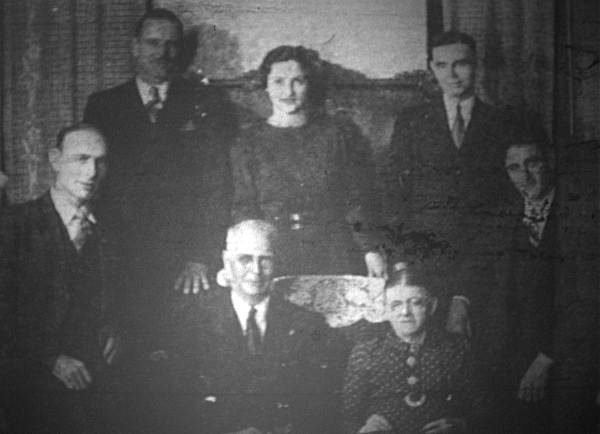
10 Judge John N. Brockman Family In front, from left to right are Basil, Judge and Mrs. Brockman and Oliver. In back, from left are: Otis, Mary and Dewey. One son, Roy, died in 1920, and two other children died in infancy.
Many descendents of John M. Brockman live in Miller County and elsewhere. This historical family was one of the county’s most influential and respected.
This is the time of year when blue grass festivals begin to be held throughout this part of the country. They may be an offshoot of the old time fiddle contests commonly held throughout the area in the past. Here is an old article from the Tuscumbia Autogram reporting one of those contests:
Miller County Autogram
April 25, 1940
Fiddlers Draw Nice Crowd
The annual old time fiddlers contest held at the Tuscumbia High School auditorium last Friday night drew a very nice crowd which responded enthusiastically to the selections of the music of the Ozarks played by the eleven contestants.
Lyman Enloe of Enon won first prize in the contest, with Ike Helton of Dixon second, and Woodrow Claxton, a student at Iberia Junior College, third. Dave June of Tuscumbia won the special prize for the best fiddler over 50 years of age, while Melvin Bradley of Kaiser carried off the special prize for the best fiddler under 21 years of age. Earl Wyrick of Tuscumbia won the special prize as the best “second” in the contest. Although he did not win a prize, Charley Warden of Tuscumbia proved one of the most popular contestants. He drew the favor of the house with his foot tapping “shifts” and pantomime expressions.
Special singing by Earl and Clint Wyrick of Tuscumbia and by the Shikles sisters of Enon pleased the audience.
Considering that the contest was held in late spring when most farm people are busy, the attendance was very good. It is planned to have the affair next year some time during the winter months and a more elaborate program will be arranged. As it was, approximately 150 people were in attendance Friday night and went away talking about what an interesting time they had had.
Here is a photo of the winner of that fiddling contest, Lyman Enloe, taken quite a few years after this particular event (photo 11):
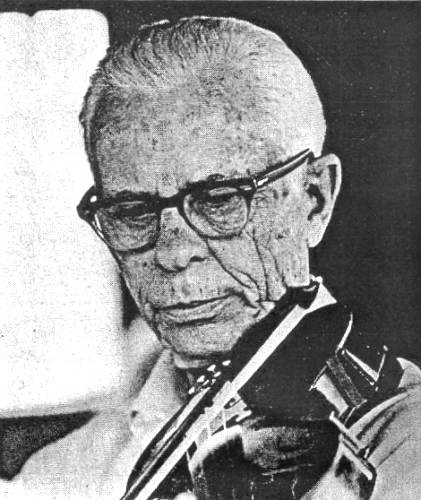
11 Lyman Enloe Lyman was considered to be one of the area’s most accomplished fiddlers all his life. I wrote about him at this previous Progress Notes.
Take a look at the article if you want to know more about Lyman and country fiddling.
Captain Robert Marshall, the famous steamboat captain of Tuscumbia, has been the subject of several previous narratives on our website. On one occasion, after he had retired, some old river friends of his visited him at his home in Tuscumbia (photos 12 and 13).
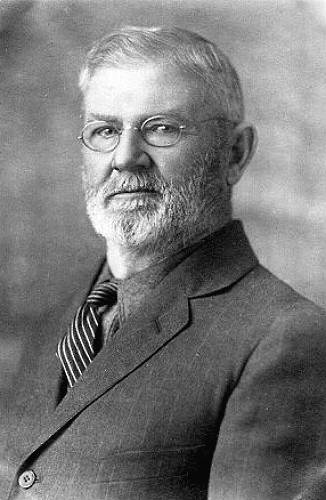
12 Bob Marshall
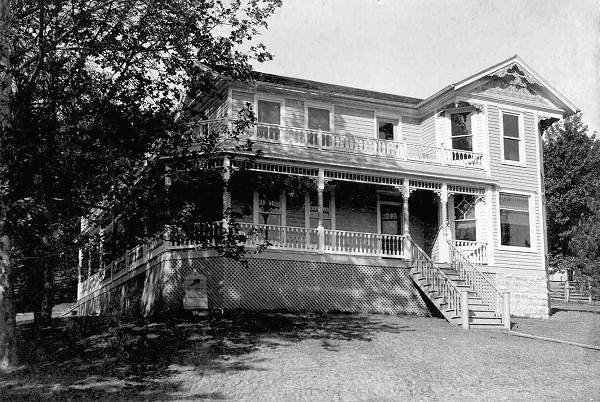
13 Bob Marshall Home One of them, William Heckman, wrote an article about the visit in the April 4th 1940 issue of “The Waterways Journal” which is copied here as published in the Miller County Autogram:
Miller County Autogram
April 25, 1940
Steamboat Bill Writes About Captain Robert M. Marshall And His Early River Days
“Steamboat Bill” writing in the April 4th issue of “The Waterways Journal,” paints an interesting picture of his old river friend, Captain Bob Marshall, and of his days as a river captain on the Osage and Missouri rivers. Steamboat Bill, ….William L. Heckman… of Hermann, Missouri and Captain Bob Marshall had many an interesting experience in river life together and have been friends and “old cronies” for many years. Mr. Heckman, with Captain Kermit Baecker, Adolph Wolf, Steamboat Bill’s brother, and “Cookie” Jeffries, recently paid Captain Marshall and his wife a visit to their beautiful home in Tuscumbia “on a picturesque hillside over looking the Osage River,” and while here took the photographs that accompany this article.
Steamboat Bill also speaks of some of Captain Bob’s other “old cronies” or river days, some of whom have passed on. Mr. Heckman, himself, lives on a “picturesque hillside” overlooking the Missouri River at Hermann, Missouri. His article follows:
At Tuscumbia, Missouri, on a picturesque hillside overlooking the Osage River, lives Captain Bob Marshall and his wife (photo 14).
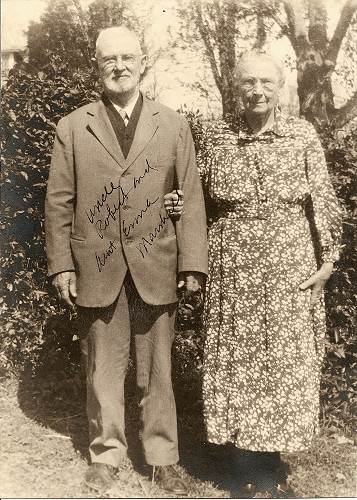
14 Bob and Emma (Hauenstein) Marshall This loving couple have now wandered down life’s golden pathway for some 59 years and around their beautiful home lingers much history of the Osage and Missouri rivers. Before her marriage Mrs. Marshall was a Hauenstein, which no doubt helped Captain Bob in his water career inasmuch as her folks were noted Osage River boatmen. Captain Bob is Scotch, which perhaps helped him to be one of the few boatmen who left the river with money enough in his pockets to become a banker, property man and mill owner.
In 1882 Captain Marshall owned the Osage River steamer Hulbert and then joined with Captain Henry Castrop (photo 15) in ownership of the steamer Frederick (photo 16).
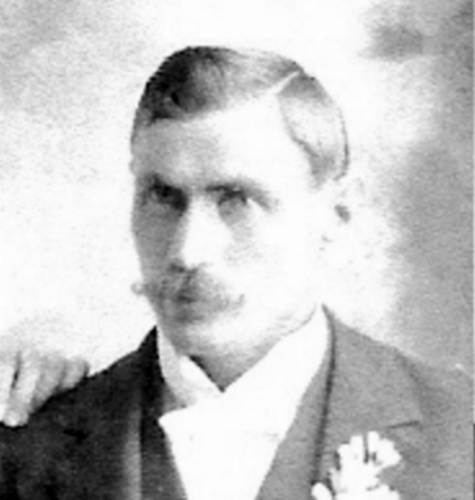
15 Henry Castrop
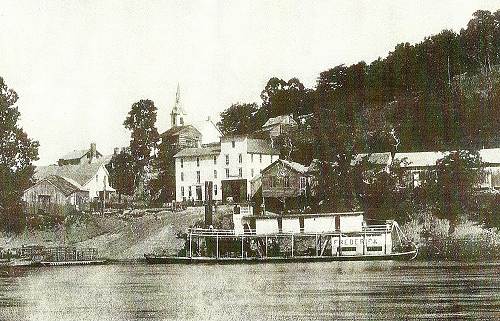
16 Steamer Frederick at Tuscumbia Landing These two boats did a big business for years in connection with the Missouri Pacific Railroad at Osage City and were very successful. Later, they bought the long, lanky packet steamer John R. Hugo (photo 17) and, with the larger boat, branched out on the Missouri River, using her as a packet and tow boat.
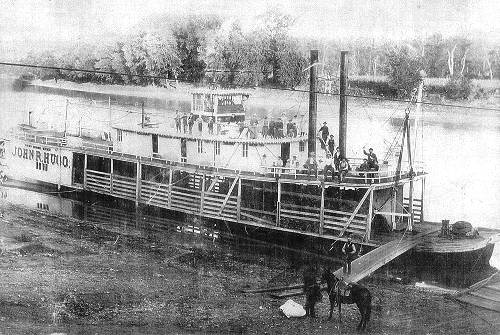
17 John R. Hugo Steamboat In the latter eighties we find the John R. Hugo towing for the Missouri River Commission up near Florence, Nebraska, and Council Bluffs, Iowa, in charge of Captain Bob Marshall and with one of the Missouri River’s most noted pilots, Bill Thompson, in the pilot house. In 1899 the Hugo lost all her upper works by fire at Florence. Some time later the hull of this boat was floated with nothing but raft oars from Florence, Nebraska to Osage City, Missouri by the Thompson brothers, Bill and Hal, which, in itself, was a noted achievement only made possible by good river men.
In 1899 Captain Bob sold out his interest in the Frederick and Hugo to Castrop and Shannon, who put the Hugo’s machinery on a brand new boat named Osage that was built by ship carpenter Ben Knagie at Osage City. This boat ran a short time on the Osage and Missouri and was then sold south. Soon after the sale the river business began fading away on the Osage. By 1920 the shadows had darkened the horizon of river activity on this little Ozark stream after lasting almost a hundred years.
Captain Tom Dodd always claimed the steamer Last Chance took 8,000 barrels of salt from the Ohio River to the usual head of navigation at Warsaw, Missouri on the Osage. One of the last new boats built for the Osage River was the Homer C. Wright named in honor of the son of Captain C.B. Wright, present manager of the Tuscumbia Anchor Milling Company (photos 18, 19 and 20).
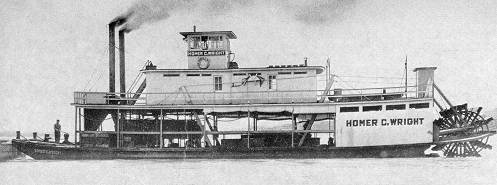
18 Homer C. Wright Steamboat
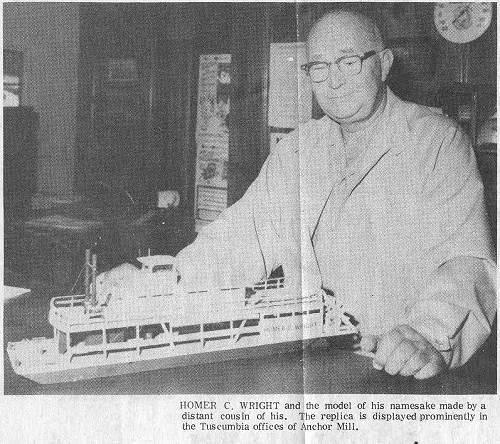
19 Homer Clay Wright- Son of C.B. Wright- with model of Steamboat Homer C. Wright
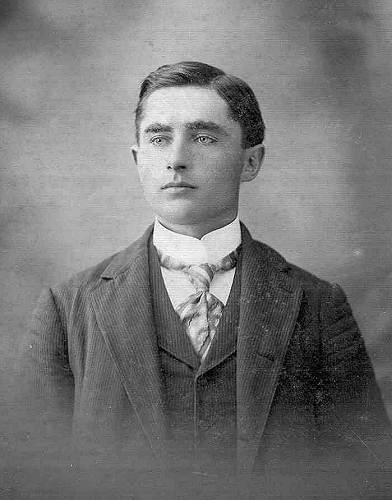
20 Clarence Boyce Wright The steamer Homer C. Wright was built on the banks of the Osage River at what is now the site of Riverside Park by carpenters J. Frank Wright and Dan Thompson (photos 21 and 22).
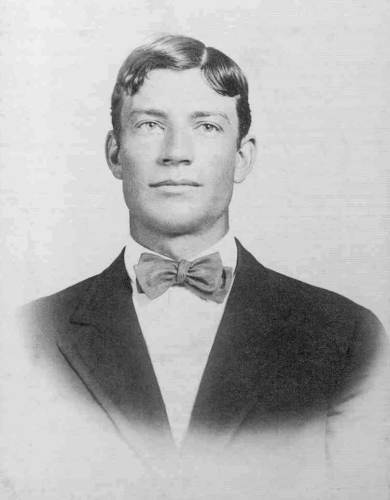
21 James Franklin Wright
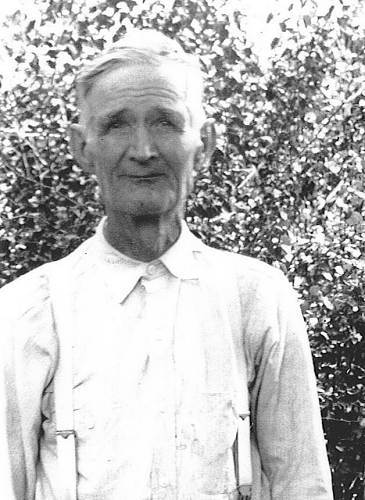
22 Dan Thompson It was caulked by Frank Maylee and painted by John Wright (photos 23 and 24).
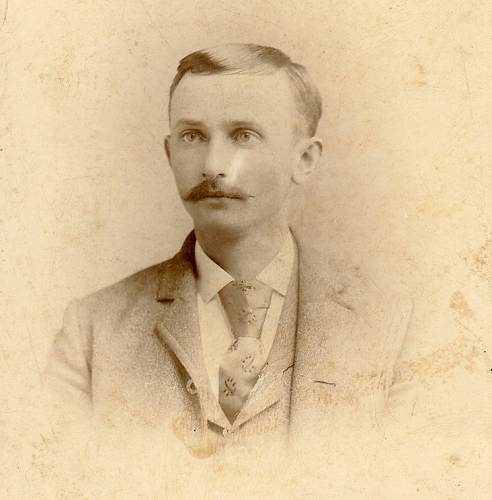
23 Frank Maylee
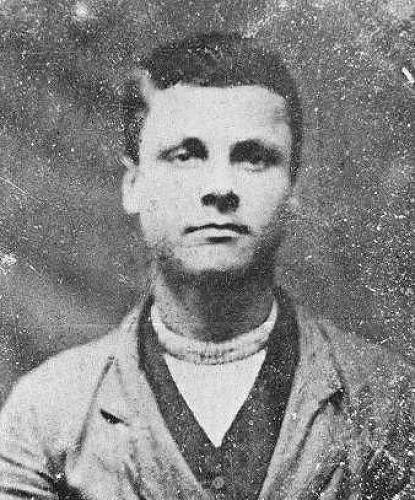
24 John Wright - About 1890 The Homer C. Wright was launched in 1919, and was used by the Anchor Milling Company for several years to transport freight on the Osage.
Captain Henry Castrop died in 1936 in his country home near Horseshoe Lake in Cambridge Bend in sight of the Missouri River.
Captain William D. Earp did his first boating for Marshall and Castrop, as did also Charlie Jenkins, a retired U.S. marine engineer living at Eugene, Missouri.
“Time marches on.” Captain Bob and his good wife are traveling four square to the wind with Time, and may they have many more happy days together before the bell rings for them to go on watch in that unknown world where they have melodious whistles on all steamboats and no railroads at all! At least this is the wish of Captain Kermit Baecker, Adolph Wolf, Steamboat Bill, and Brother and Cookie Jeffries, who lately had a pleasant visit with Captain Marshall and his wife.
William L. Heckman
Did you know that one of the world’s most used inventions came from little Aurora Springs? It was the hook for lacing up shoes which replaced the “eyes” formerly used. The first I read about it was in an old edition of the Miller County Autogram published in 1890 which copied the news item from an eastern New York newspaper. Here is the short news item as it appeared in the Autogram:
Miller County Autogram
May 22, 1890
“It is not generally known even among the shoe dealers,” said a shoe manufacturer, “that the hooks which serve in place of eyes for the laces of men’s shoes were invented by a little watch maker in Aurora Springs, Missouri. His name is Klinger, and he still lives there working at his trade. He sold his patent for the hooks to a Boston man who was out there looking for health, the price paid being $500. Last year the royalties on these hooks yielded the present owner of the patent the net income of $300,000.”….New York Sun
After reading that item in the Autogram I checked and found that indeed, in that time frame, a man named Klinger did have a store in Aurora Springs. His name was Alexander Klinger who was a jeweler and tiff miner. This information can be found on our own website on the page which gives the history of Aurora Springs.
I researched the origin of shoe hooks and found that the name of the man who bought the patent from Klinger was Laroy Sunderland Starrett (photo 25).
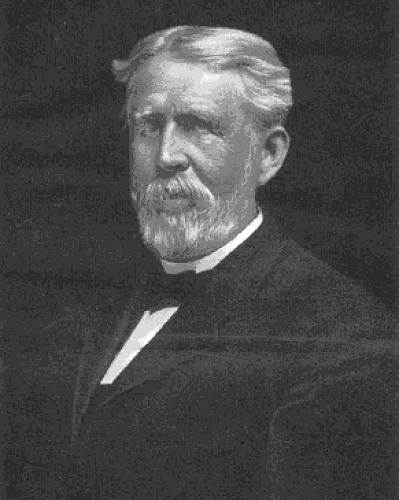
25 Laroy Sunderland Starrett His story of success in business is a true testament to what can be accomplished if one has some ingenuity and willingness to work hard. Here is a short biography of this far sighted business man who came west for a vacation at Aurora Springs, famous in those days for the purported health and healing qualities of its spring:
The National Cyclopaedia of American Biography, Volume XVIII (New York: James T. White and Company, 1922) p. 428
Laroy Sunderland Starrett, tool manufacturer, was born at China, Maine, April 25, 1836, son of Daniel D. and Anna Elizabeth (Crummet) Starrett, and a descendant of William Starrett, who came to America from Scotland and settled at Francistown, New Hampshire, about 1720. He inherited his taste for mechanics from both parents; his mother was a woman of considerable mechanical ingenuity and ability, and with the aid of her daughters made all the clothes for the family, weaving the cloth on a loom made by her husband, who was a natural mechanic. Laroy was brought up on his father’s farm, and when his father became embarrassed financially secured employment on a stock farm at Vassalboreo, Maine, and later on a milk farm at Newburyport, Massachusetts to help pay off the debt on the homestead. He operated a farm of his own for a time in Newburyport, Massachusetts and astonished his neighbors by purchasing the first mowing machine used in that part of the country. His inventive genius was first displayed in the construction of a meat chopper, for which he obtained a patent May 2, 1865. After arranging for its manufacture, he undertook to sell personally both the chopper and the patent rights for it throughout the state of Maine. The venture proved so successful that he made a contract with the Athol Massachusetts Machine Company to manufacture his meat chopper and other inventions of his own, among which were shoe studs and hooks, patented January 28, 1868, and now used with slight modification the world over.
Deciding to establish a business of his own, he began the manufacture of a combination square, consisting of a try square with a movable head that may be clamped in any desired position along the blade, in Athol, Massachusetts in 1880. First patented February 26, 1879, his combination square has been improved in many details and has become a most useful tool in the building trade. Gradually he added steel rules, surface gauges, screw pitch gauges and other small tools to his list, and by 1885 the expansion of the business necessitated the acquisition of a second building. The success and growth of the business have been continuous until at the time of his death the plant at Athol, Massachusetts was the largest in the world devoted exclusively to the manufacture of small tools and hacksaw blades, containing over five acres of floor space and employing over 1000 hands. The factories are equipped throughout with machinery of the highest class and with every up to date appliance for the accurate production of fine mechanical tools. In 1912 the company was incorporated as the L.S. Starrett Company with capital stock of $3,500,000 and of which Mr. Laroy S. Starrett was president until his death. It manufactures a large line of carefully adjusted rules, measures, gauges, squares, protractors, slide rules, calipers, dividers, pliers, hacksaws, wrenches, screw drivers and levels, all of which were originated or perfected by Mr. Starrett himself. He designed to find the exact center of a circle, patented June 29, 1880; a surface gauge, patented March 21, 1882; a beveling instrument, August 7, and December 4, 1883; screw thread gauge, May 19, 1885; calipers and dividers, December 27, 1887; micrometer caliper square, March 5, 1889; micrometer gauge, July 29, 1890; bevel protractor, May 10, 1892. He was a member of the Home Market Club of Boston and attended the Methodist Episcopal Church. He was married in Newburyport, Massachusetts in 1861, to Lydia, daughter of Henry A. Bartlett, and has had five children. He died at his home in St. Petersburg, Florida, April 23, 1922.
Even though Laroy Starrett died in 1922 his business still exists and is of multinational size.
Ginny Duffield of Vernon Publishing Company was very kind to come to our May 15 Open House season opener event to take some pictures for the Advertiser and Autogram (photos 26 and 27).
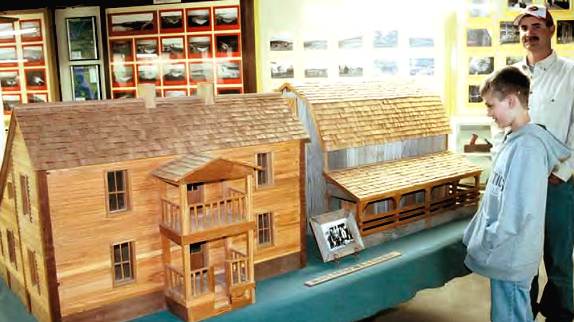
26 Mason and his father Bruce Kemna Eldon Advertiser
May 20, 2010
St. Elizabeth’s Mason Kemna and his father Bruce Kemna enjoy looking over the models of the house and barn of the Oligschlaeger family farm. Robert Urban Oligschlaeger, their relative, spent more than 17 years working on the projects and recently donated them to the Miller County Historical Society Museum in Tuscumbia and visitors to the open house Saturday, May 15, got the first looks at the new display. Oligschlager formerly owned Anchor Mill Comapny and he was reared in St. Elizabeth. He and his wifenow live in Iowa. The original house still stands south of Highway 52 on the east side of St. Elizabeth. (Photo by Ginny Duffield)

27 Prime Visiting Spot Miller County Autogram
May 20, 2010
The research area of the Miller County Historical Society’s museum in Tuscumbia was a prime spot for visiting Saturday, May 15, during the society’s open house held to showcase new exhibits. The museum also is now open for the season. (Photo by Ginny Duffield)
We are very appreciative of the work Ginny does not only in covering our events but many others every week elsewhere. She is a very conscientious journalist devoted to informing the public about what is going on in our county as well as offering constructive suggestions in her weekly column in the Autogram.
That’s all for this week.
 Joe Pryor
Previous article links are in a dropdown menu at the top of all of the pages.
|

